2021-2022学年人教版高中英语:必修5 Unit 1 Great scientists 1.2 Reading课件(34张)
文档属性
| 名称 | 2021-2022学年人教版高中英语:必修5 Unit 1 Great scientists 1.2 Reading课件(34张) |  | |
| 格式 | ppt | ||
| 文件大小 | 1.2MB | ||
| 资源类型 | 教案 | ||
| 版本资源 | 人教版(新课程标准) | ||
| 科目 | 英语 | ||
| 更新时间 | 2021-08-16 16:50:53 | ||
图片预览

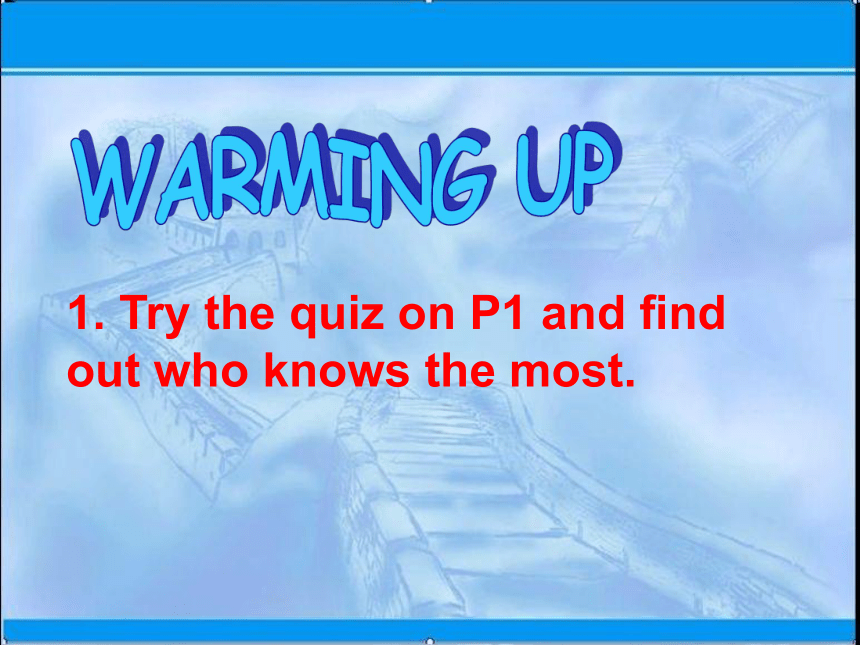
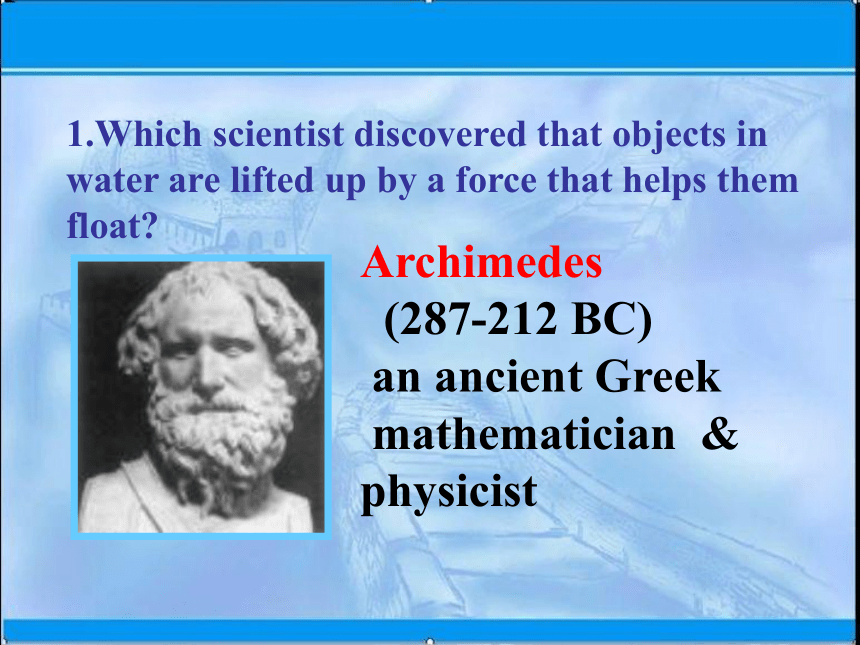
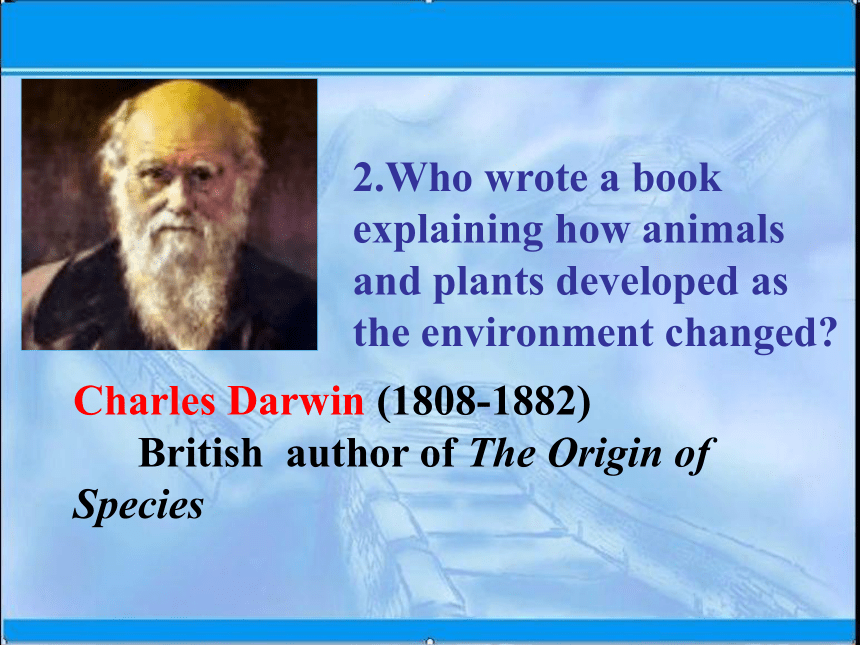

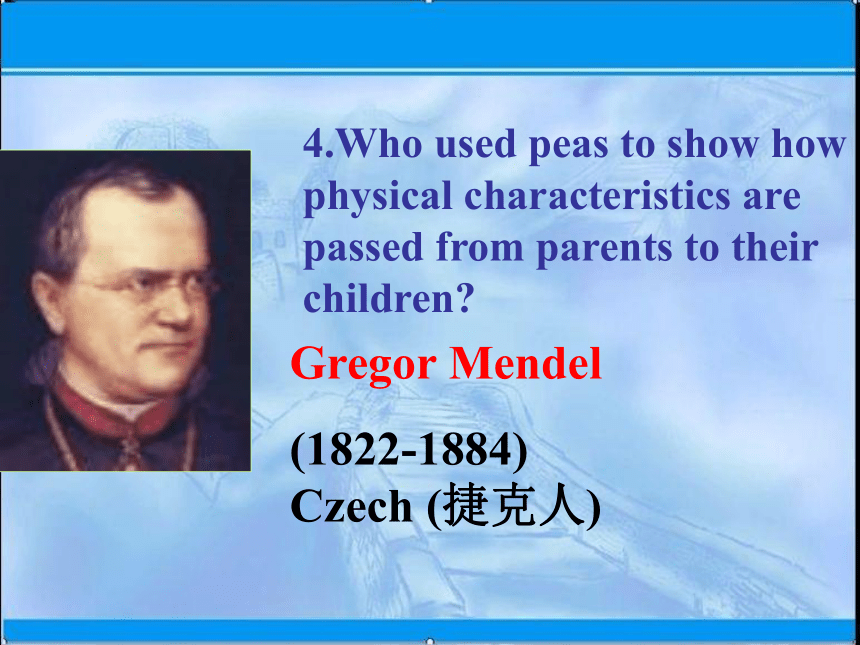
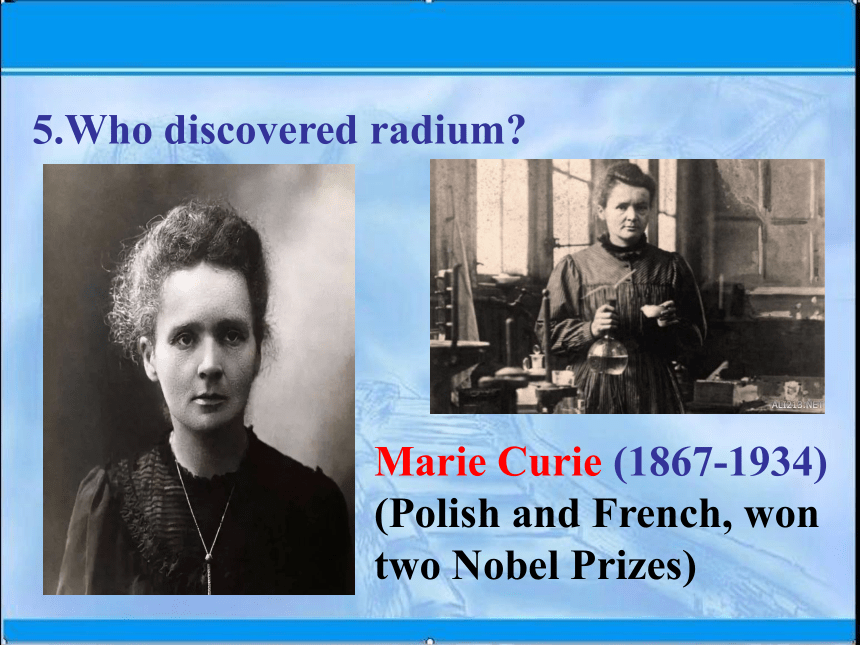
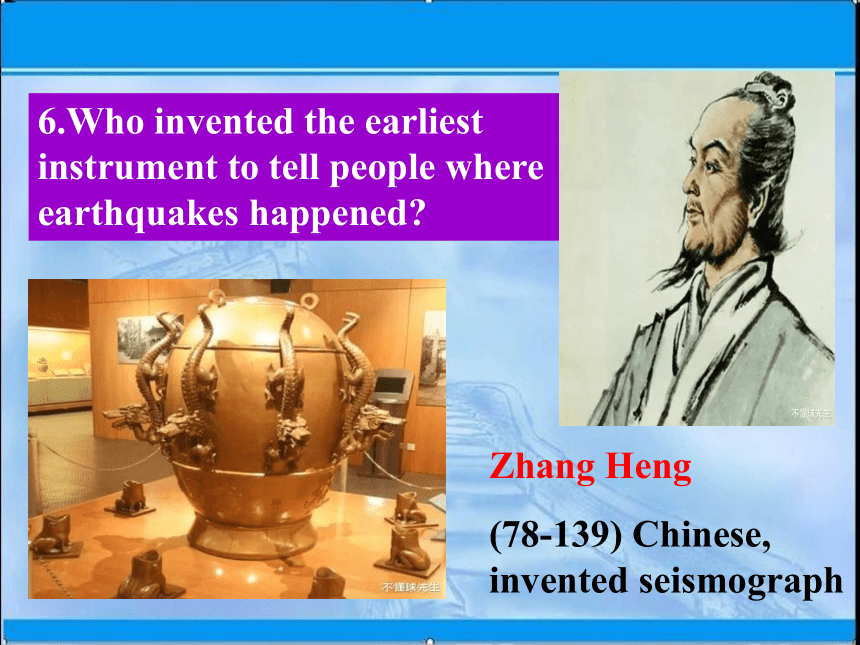
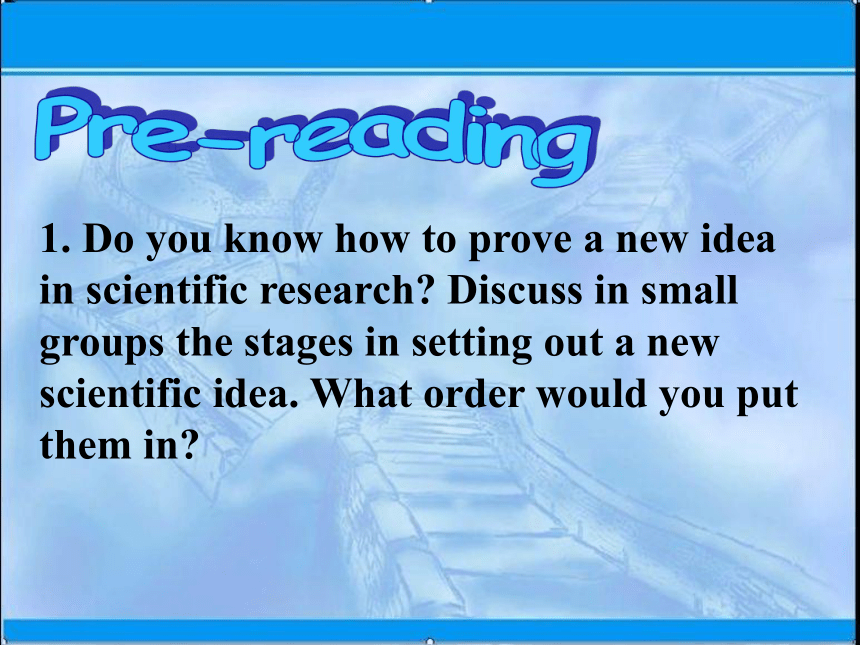
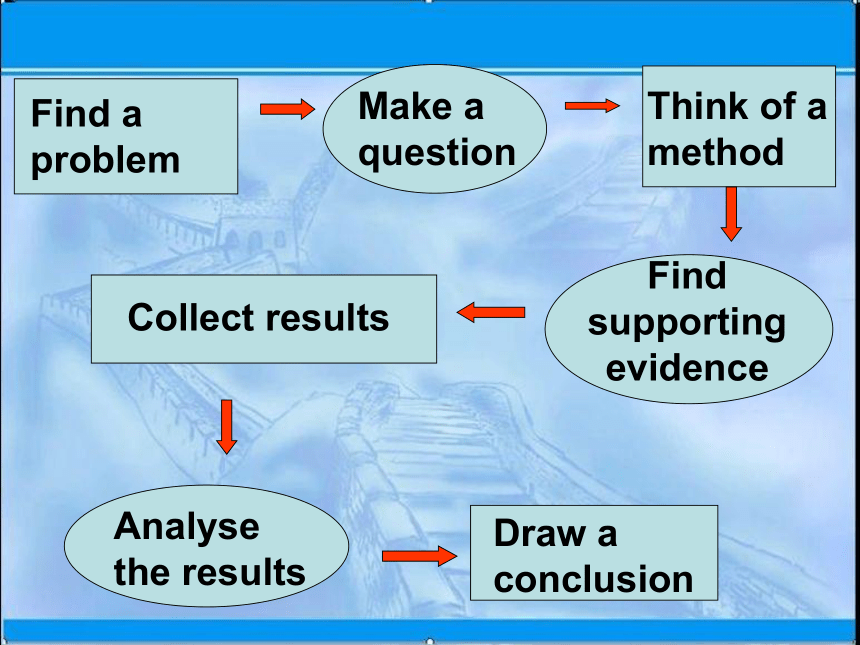
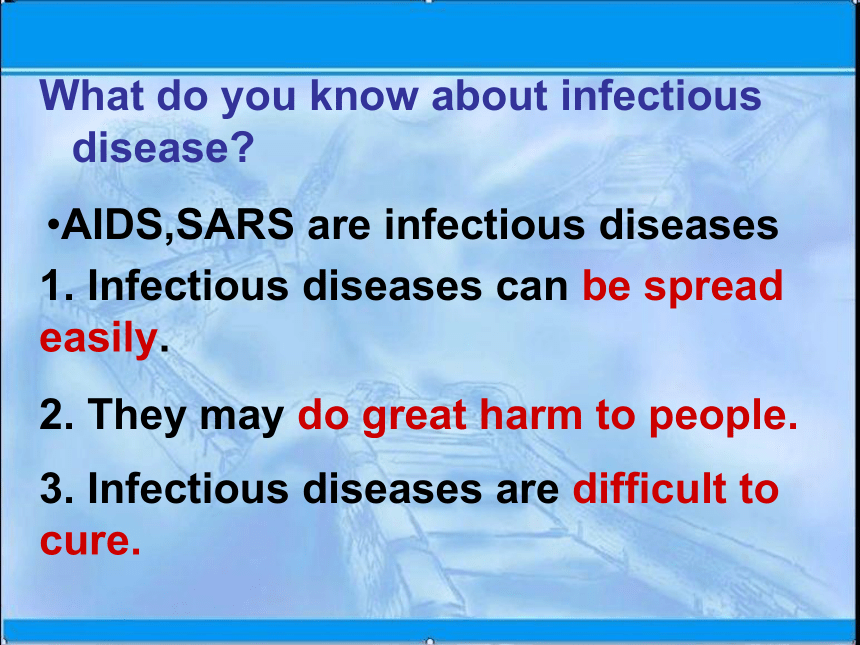

文档简介
Unit1Great Scientists
Reading
1. Try the quiz on P1 and find out who knows the most.
1.Which scientist discovered that objects in water are lifted up by a force that helps them float?
Archimedes
(287-212 BC)
an ancient Greek
mathematician & physicist
2.Who wrote a book explaining how animals and plants developed as the environment changed?
Charles Darwin (1808-1882)
British author of The Origin of Species
3.Who invented the first steam engine?
Thomas Newcomen (1663-1729) British, improved the first steam pump and turned it into a steam engine for taking water out of mines in 1712. James Watt improved it and turned it into the first modern steam engine used on the railways.
4.Who used peas to show how physical characteristics are passed from parents to their children?
Gregor Mendel
(1822-1884) Czech (捷克人)
5.Who discovered radium?
Marie Curie (1867-1934) (Polish and French, won two Nobel Prizes)
6.Who invented the earliest instrument to tell people where earthquakes happened?
Zhang Heng
(78-139) Chinese, invented seismograph
1. Do you know how to prove a new idea in scientific research? Discuss in small groups the stages in setting out a new scientific idea. What order would you put them in?
Find a problem
Think of a method
Make a question
Collect results
Analyse the results
Find supporting evidence
Draw a conclusion
What do you know about infectious disease?
1. Infectious diseases can be spread easily.
2. They may do great harm to people.
AIDS,SARS are infectious diseases
3. Infectious diseases are difficult to cure.
What do you know about cholera?
Cholera is caused by a bacterium called Varian cholera(霍乱弧菌).
It infects people’s intestines (肠胃), causing diarrhea(腹泻), vomiting and leg cramps (腿抽筋).
The most common cause of cholera is people eat food or drink water that has been polluted by the bacteria.
John Snow
Cholera
John Snow 约翰 斯诺(1813 ~ 1858),英国麻醉学家、流行病专家。他首次提出了预防霍乱的措施。1854年,伦敦霍乱流行,斯诺通过研究霍乱病死者的日常生活情况,寻找到他们的共同行为模式,发现了霍乱与饮用不洁水的关系,由于及时切断了二者的联系,有效制止了霍乱的流行。
John Snow 约翰 斯诺(1813 ~ 1858),英国麻醉学家、流行病专家。他首次提出了预防霍乱的措施。1854年,伦敦霍乱流行,斯诺通过研究霍乱病死者的日常生活情况,寻找到他们的共同行为模式,发现了霍乱与饮用不洁水的关系,由于及时切断了二者的联系,有效制止了霍乱的流行。
What’s the main idea of the passage?
John Snow was a well-known doctor in London.
The cause of Cholera was polluted water.
The source of all drinking water should be examined.
How did John Snow collect, analyze the information, find the cause of the disease and solve it .
Read the passage and match each paragraph with
its main idea?
Para.1 A. Offer solutions.
Para.2 B. Analyse the resluts.
Para.3 C. Provide two control theories.
Para.4 D. Collect information.
Para.5 E. Collect results.
Para.6 F. Outbreak of cholera.
Para.7 G. Find supporting evidence.
Use the seven stages in examining a new scientific idea to describe each paragraph.
Steps:
What/How?
1.Find a
problem
2.Make up a
question
3.Think of a
method
4.Collect
results
The cholera was the most diease of its
day.Neither its course nor its cure was
understood.
Theory1: Cholera multiplied in the without
reason.
Theory2: People absorbed it with their .
Gather when another Cholera hit London in 1854.
He marked on a where all the dead people had lived and found the water from pump was .
6. Find supporting evidence
7.Make a conclusion
5.Analyse
results
The water was from the river which had been by the dirty water from London.
A woman and her daughter who lived far away but drank the water also .
The polluted water carried the
.The source of all drinking
water should be .
Careful Reading:
John Snow was an doctor in London who Queen Victoria as her personal . He thought about helping ordinary people to cholera. Though the cause and the of it were unknown, he wanted to face
the and solve the problem.
expert
attended
physician
exposed
cure
challenge
What were the two theories about the cause of cholera?
Which did John Snow want to prove?
What was his method of doing the research?
…multiplied… …victims…
…absorb…
The second one.
To gather information in two particular streets.
What did he do with the results of his enquiry?
What valuable clue did he get about the cause of the disease?
What might be the cause?
Marked on a map…
Many of the deaths…
…had no deaths.
It seemed that the water was to blame for cholera.
Why did he tell people to remove the handle from the pump?
What happened after the handle was removed?
So that …
…slowed down
Where did the woman live and what did she had delivered to her house every day?
What did their deaths suggest?
What measures did John Snow take to prevent the disease from spreading?
Away from Broad Street
Water from the pump
The polluted water carried the virus
..suggested that…be examined
…were instructed not to expose…to…
John Snow was a well-known ______ in London in the ___ century. He wanted to find the ______ of cholera in order to ______ it. In 1854 when a cholera ____ out, he began to gather information. He _____ on a map where all the dead people had lived and he found that many people who had drunk the dirty water from the ______ died. So he decided that the polluted water carried cholera. He suggested that the _____ of all water supply be _______ and new methods of ________ with polluted water be found. Finally, “King Cholera” was defeated.
doctor
19th
cause
defeat
broke
marked
pump
source
examined
dealing
重点句型
1. Neither its cause nor its cure was understood.
句式剖析
Neither...nor...意为“既不...也不...”,
1.可连接词性相同的词、词组或结构,表示完全否定
2.连接两个名词或代词作主语时,谓语动词使用就近一致原则
3.连接两个句子且放在句首,则两个句子都必须部分倒装
eg. Neither did I go to watch the football match nor did I care its result.
2. So many thousands of terrified people died every time there was an outbreak.
句式剖析
So many thousands of terrified people died为主句,every time 引导时间状语从句,连词,意为“每当...,每次...”,相当于whenever.
其他用作连词的名词短语主要有:
1. 表示习惯性、经常性的动作或”第几次做某事“,有:every time, each time, next time, the first/second...time等
eg. The first time I went there, they were living in a small house with dogs,ducks,and other animals.
2. 表示瞬间变化,含有“一···就···” the moment, the minute, the second,immediately
He was out the moment I got to his house.
I recognized you the minute I saw you.
---When did he leave the classroom?
---He left ____ you turned back to write on the blackboard.
the minute B. the time
C. until D. before
根据中文提示,完成下列句子
(1)每次我去找他,他都在专心看书。
__________I went to see him, he was absorbed in reading.
(2)我一见到她就把这本书给了她。
I gave the book to her ____________I saw her.
Every time
the moment
3. A woman, who had moved away from Broad Street, liked the water from the pump so much that she had it delivered to her house every day.
句式剖析
1. who引导的非限制性定语从句,修饰先行词A woman
2. so...that 引导结果状语从句
3. “have sth. done” 结构
①(主语)请/派别人完成某事
eg. You should understand the traffic rule by now. You have had it exolained often enough.
②(主语)完成某事(可能参与,也可能不参与)
eg. Before you came back I had had all my mistakes corrected.
③(主语)遭受某种不幸的情况
eg. I had my leg broken when I got off the bus,
I had my watch stolen last night.
练习
--My computer is out of function again.
--You need to go to the customer service center and have it
(repair).
repaired
Reading
1. Try the quiz on P1 and find out who knows the most.
1.Which scientist discovered that objects in water are lifted up by a force that helps them float?
Archimedes
(287-212 BC)
an ancient Greek
mathematician & physicist
2.Who wrote a book explaining how animals and plants developed as the environment changed?
Charles Darwin (1808-1882)
British author of The Origin of Species
3.Who invented the first steam engine?
Thomas Newcomen (1663-1729) British, improved the first steam pump and turned it into a steam engine for taking water out of mines in 1712. James Watt improved it and turned it into the first modern steam engine used on the railways.
4.Who used peas to show how physical characteristics are passed from parents to their children?
Gregor Mendel
(1822-1884) Czech (捷克人)
5.Who discovered radium?
Marie Curie (1867-1934) (Polish and French, won two Nobel Prizes)
6.Who invented the earliest instrument to tell people where earthquakes happened?
Zhang Heng
(78-139) Chinese, invented seismograph
1. Do you know how to prove a new idea in scientific research? Discuss in small groups the stages in setting out a new scientific idea. What order would you put them in?
Find a problem
Think of a method
Make a question
Collect results
Analyse the results
Find supporting evidence
Draw a conclusion
What do you know about infectious disease?
1. Infectious diseases can be spread easily.
2. They may do great harm to people.
AIDS,SARS are infectious diseases
3. Infectious diseases are difficult to cure.
What do you know about cholera?
Cholera is caused by a bacterium called Varian cholera(霍乱弧菌).
It infects people’s intestines (肠胃), causing diarrhea(腹泻), vomiting and leg cramps (腿抽筋).
The most common cause of cholera is people eat food or drink water that has been polluted by the bacteria.
John Snow
Cholera
John Snow 约翰 斯诺(1813 ~ 1858),英国麻醉学家、流行病专家。他首次提出了预防霍乱的措施。1854年,伦敦霍乱流行,斯诺通过研究霍乱病死者的日常生活情况,寻找到他们的共同行为模式,发现了霍乱与饮用不洁水的关系,由于及时切断了二者的联系,有效制止了霍乱的流行。
John Snow 约翰 斯诺(1813 ~ 1858),英国麻醉学家、流行病专家。他首次提出了预防霍乱的措施。1854年,伦敦霍乱流行,斯诺通过研究霍乱病死者的日常生活情况,寻找到他们的共同行为模式,发现了霍乱与饮用不洁水的关系,由于及时切断了二者的联系,有效制止了霍乱的流行。
What’s the main idea of the passage?
John Snow was a well-known doctor in London.
The cause of Cholera was polluted water.
The source of all drinking water should be examined.
How did John Snow collect, analyze the information, find the cause of the disease and solve it .
Read the passage and match each paragraph with
its main idea?
Para.1 A. Offer solutions.
Para.2 B. Analyse the resluts.
Para.3 C. Provide two control theories.
Para.4 D. Collect information.
Para.5 E. Collect results.
Para.6 F. Outbreak of cholera.
Para.7 G. Find supporting evidence.
Use the seven stages in examining a new scientific idea to describe each paragraph.
Steps:
What/How?
1.Find a
problem
2.Make up a
question
3.Think of a
method
4.Collect
results
The cholera was the most diease of its
day.Neither its course nor its cure was
understood.
Theory1: Cholera multiplied in the without
reason.
Theory2: People absorbed it with their .
Gather when another Cholera hit London in 1854.
He marked on a where all the dead people had lived and found the water from pump was .
6. Find supporting evidence
7.Make a conclusion
5.Analyse
results
The water was from the river which had been by the dirty water from London.
A woman and her daughter who lived far away but drank the water also .
The polluted water carried the
.The source of all drinking
water should be .
Careful Reading:
John Snow was an doctor in London who Queen Victoria as her personal . He thought about helping ordinary people to cholera. Though the cause and the of it were unknown, he wanted to face
the and solve the problem.
expert
attended
physician
exposed
cure
challenge
What were the two theories about the cause of cholera?
Which did John Snow want to prove?
What was his method of doing the research?
…multiplied… …victims…
…absorb…
The second one.
To gather information in two particular streets.
What did he do with the results of his enquiry?
What valuable clue did he get about the cause of the disease?
What might be the cause?
Marked on a map…
Many of the deaths…
…had no deaths.
It seemed that the water was to blame for cholera.
Why did he tell people to remove the handle from the pump?
What happened after the handle was removed?
So that …
…slowed down
Where did the woman live and what did she had delivered to her house every day?
What did their deaths suggest?
What measures did John Snow take to prevent the disease from spreading?
Away from Broad Street
Water from the pump
The polluted water carried the virus
..suggested that…be examined
…were instructed not to expose…to…
John Snow was a well-known ______ in London in the ___ century. He wanted to find the ______ of cholera in order to ______ it. In 1854 when a cholera ____ out, he began to gather information. He _____ on a map where all the dead people had lived and he found that many people who had drunk the dirty water from the ______ died. So he decided that the polluted water carried cholera. He suggested that the _____ of all water supply be _______ and new methods of ________ with polluted water be found. Finally, “King Cholera” was defeated.
doctor
19th
cause
defeat
broke
marked
pump
source
examined
dealing
重点句型
1. Neither its cause nor its cure was understood.
句式剖析
Neither...nor...意为“既不...也不...”,
1.可连接词性相同的词、词组或结构,表示完全否定
2.连接两个名词或代词作主语时,谓语动词使用就近一致原则
3.连接两个句子且放在句首,则两个句子都必须部分倒装
eg. Neither did I go to watch the football match nor did I care its result.
2. So many thousands of terrified people died every time there was an outbreak.
句式剖析
So many thousands of terrified people died为主句,every time 引导时间状语从句,连词,意为“每当...,每次...”,相当于whenever.
其他用作连词的名词短语主要有:
1. 表示习惯性、经常性的动作或”第几次做某事“,有:every time, each time, next time, the first/second...time等
eg. The first time I went there, they were living in a small house with dogs,ducks,and other animals.
2. 表示瞬间变化,含有“一···就···” the moment, the minute, the second,immediately
He was out the moment I got to his house.
I recognized you the minute I saw you.
---When did he leave the classroom?
---He left ____ you turned back to write on the blackboard.
the minute B. the time
C. until D. before
根据中文提示,完成下列句子
(1)每次我去找他,他都在专心看书。
__________I went to see him, he was absorbed in reading.
(2)我一见到她就把这本书给了她。
I gave the book to her ____________I saw her.
Every time
the moment
3. A woman, who had moved away from Broad Street, liked the water from the pump so much that she had it delivered to her house every day.
句式剖析
1. who引导的非限制性定语从句,修饰先行词A woman
2. so...that 引导结果状语从句
3. “have sth. done” 结构
①(主语)请/派别人完成某事
eg. You should understand the traffic rule by now. You have had it exolained often enough.
②(主语)完成某事(可能参与,也可能不参与)
eg. Before you came back I had had all my mistakes corrected.
③(主语)遭受某种不幸的情况
eg. I had my leg broken when I got off the bus,
I had my watch stolen last night.
练习
--My computer is out of function again.
--You need to go to the customer service center and have it
(repair).
repaired
